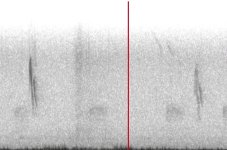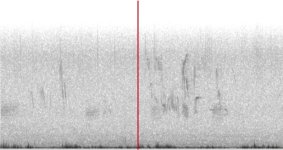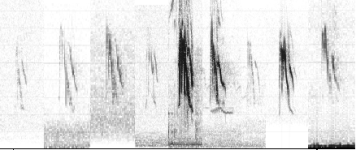
Habitat: tall grass and herbage, bushes, scattered trees, ditch, river
1) Here are two clips identified as a singing Whinchat by Merlin, and, while I'd be inclined to believe it given the clips are pretty long (and the original was even longer), I'd prefer to tick it when I'm able to better tell it from Stonechat. Despite some effort, I wasn't able to see any Whinchats there, only a Stonechat. I did watch BTO's ID video about chats (Whinchat: short bursts of song, long pauses, mimicry), and I even heard a Stonechat sing earlier today, but I'd still be happy to hear your advice for seperating the two.
2) This is what Merlin identified as Tawny Pipit (an uncommon migrant/breeder in Poland). If it's indeed it, could you please tell me whether the squeaky whistle at the very beginning is a part of its song or a different species altogether (Merlin started hearing Tawny Pipit only from around 0:16).
3) I enjoyed some great views of a singing Wryneck, and it also appeared to be the bird responsible for emitting series of thin tinkling sounds. They sounded pretty close to what Merlin describes as 'juvenile calls': ML356480091 Eurasian Wryneck Macaulay Library. So, is it possible that these 'juvenile calls' are also made by adults (as would be the case here)? I could've made a better recording, but my battery went down; anyway, I think managed to record these calls earlier on (hopefully it's the same thing). I believe that, eventually, it strung together more than 3-4 such tinkles.
4) I don't post queries about every single sound I can't ID, but these flat, slightly wavy whistles appear interesting to me because they lasted for so long and because Merlin hasn't a clue, nor do I. Slightly similar to a Nightingale/Willow Tit/Willow Warbler, but not quite. I'd normally ask BirdNET's website for suggestions, but it's consistently failed to load for a few days now, on different devices, in different networks and browsers.
1) Here are two clips identified as a singing Whinchat by Merlin, and, while I'd be inclined to believe it given the clips are pretty long (and the original was even longer), I'd prefer to tick it when I'm able to better tell it from Stonechat. Despite some effort, I wasn't able to see any Whinchats there, only a Stonechat. I did watch BTO's ID video about chats (Whinchat: short bursts of song, long pauses, mimicry), and I even heard a Stonechat sing earlier today, but I'd still be happy to hear your advice for seperating the two.
2) This is what Merlin identified as Tawny Pipit (an uncommon migrant/breeder in Poland). If it's indeed it, could you please tell me whether the squeaky whistle at the very beginning is a part of its song or a different species altogether (Merlin started hearing Tawny Pipit only from around 0:16).
3) I enjoyed some great views of a singing Wryneck, and it also appeared to be the bird responsible for emitting series of thin tinkling sounds. They sounded pretty close to what Merlin describes as 'juvenile calls': ML356480091 Eurasian Wryneck Macaulay Library. So, is it possible that these 'juvenile calls' are also made by adults (as would be the case here)? I could've made a better recording, but my battery went down; anyway, I think managed to record these calls earlier on (hopefully it's the same thing). I believe that, eventually, it strung together more than 3-4 such tinkles.
4) I don't post queries about every single sound I can't ID, but these flat, slightly wavy whistles appear interesting to me because they lasted for so long and because Merlin hasn't a clue, nor do I. Slightly similar to a Nightingale/Willow Tit/Willow Warbler, but not quite. I'd normally ask BirdNET's website for suggestions, but it's consistently failed to load for a few days now, on different devices, in different networks and browsers.









